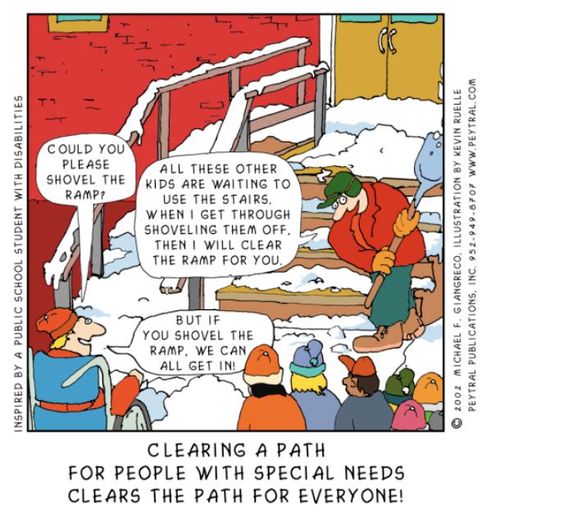At a conference in Burnaby last Spring, the keynote speaker, Shelley Moore, shared a graphic similar to this one. The green circles are typical learners and the red, yellow, and blue circles are people with learning differences.
And then she made the observation that this graphic still promotes a problematic view of being inclusive and shared this graphic with us.
The key difference is that the updated graphic recognizes that there is variation between all of us. By using green to mean typical and the other colours to mean atypical, there is still a false dichotomy created between the two groups of learners. In a practical sense, many disabilities are defined by an arbitrary line drawn on a measure of the range of human ability.
But, we should not ignore the diversity in our learners. Some learners really do need different supports than others. The key is to recognize that many instructional supports intended for some learners are actually helpful for all learners.1 2

All students benefit from sufficient time to think and to process. All students benefit from a public record of what is being discussed. All students benefit from making mathematical ideas explicit. All students benefit from teachers who have high expectations for their capacity to learn.
1. A side note here: there are a small number of disabilities people have which do require very different supports that are unhelpful for other students. In those cases, using targeted support is warranted provided one does so while recognizing the learners are part of the varied tapestry of humanity.
2. These ideas around inclusion for all are also a central theme of the book, Routines for Reasoning.


Susan Jones says:
Resounding Amen here.
Lots of those “greenies” are a whole lot more complicated!!!
… some “different supports” are conflicting. My folks who *need* to see the “big picture” drown in the details that my “I need to build from the parts!” learners *need.* You need *no distractions* — silence makes me crazy!
Routines for Reasoning makes me sing and dance (and dancing says something ) because it’s so full of the conscious connectors between language and visual adn intuitive… I just got my hard copy ’cause I was sickupandfed of it being on my devices 🙂
July 12, 2019 — 11:08 pm
Christine says:
Thanks for your thoughts on this. I have seen and worked with Shelley Moore on many occasions and am continually inspired by her. I appreciate how you highlighted the updated graphic for inclusion as it is more reflective of actual classrooms. It reminds us that every learner presents with their own repertoire of strengths and stretches and that our role is to meet the diverse needs of our diverse learners. I completely agree with you that many instructional supports intended for specific learners in fact benefit all learners. In terms of planning, teaching, and assessing it is best addressed through Universal Design for Learning and differentiated instruction. Great title, by the way. I am a firm believer of inclusion. Thanks for sharing.
August 6, 2019 — 8:19 pm
David says:
This!
September 22, 2023 — 4:29 pm